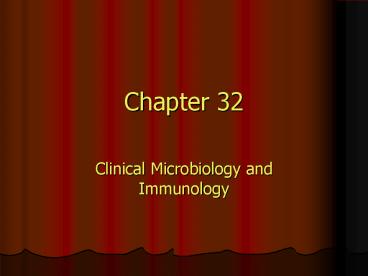Clinical Microbiology and Immunology - PowerPoint PPT Presentation
1 / 24
Title:
Clinical Microbiology and Immunology
Description:
Chapter 32 Clinical Microbiology and Immunology Specimens Clinical microbiologist major function is to isolate and identify microbes from clinical specimens rapidly ... – PowerPoint PPT presentation
Number of Views:1103
Avg rating:3.0/5.0
Title: Clinical Microbiology and Immunology
1
Chapter 32
- Clinical Microbiology and Immunology
2
Specimens
- Clinical microbiologist
- major function is to isolate and identify
microbes from clinical specimens rapidly - Clinical specimen
- portion or quantity of human material that is
tested, examined, or studied to determine the
presence or absence of specific microbes
3
Working with Specimens
- Safety concerns
- Standard Microbiological Practices have been
established by the Centers for Disease Control
and Prevention (CDC) - Specimen should
- represent diseased area and other appropriate
sites - be large enough for carrying out a variety of
diagnostic tests - be collected in a manner that avoids
contamination - be forwarded promptly to clinical lab
- be obtained prior to administration of
antimicrobial agents, if possible
4
Identification of Microorganisms from Specimens
- Preliminary or definitive identification of
microbe based on numerous types of diagnostic
procedures - microscopy
- growth and biochemical characteristics
- immunologic tests
- bacteriophage typing
- molecular methods
5
Collection
- numerous methods used
- choice of method depends on specimen
6
Immunofluorescence
- process in which fluorescent dyes are exposed to
UV, violet, or blue light to make them fluoresce - dyes can be coupled to antibody molecules with
changing antibodys ability to bind a specific
antigen - can be used as direct fluorescent-antibody (FA)
technique or indirect fluorescent-antibody (IFA)
technique assay
7
FA technique
Figure 32.2a
8
IFA technique
Figure 32.2b
9
Growth and Biochemical Characteristics
- techniques used depend on nature of pathogen
- for some pathogens, culture-based techniques have
limited use
10
Viruses
- Identified by
- isolation in living cells
- immunodiagnostic tests
- molecular methods
- replication in culture detected by
- cytopathic effects
- morphological changes in host cells
- hemadsorption
- binding of red blood cells to surface of infected
cells
11
Fungi
- Cultures used to recover fungus from patient
specimens - growth medium depends on type(s) of fungus being
isolated - Identification
- direct microscopic (fluorescence) examination
- immunofluorescence
- serological tests (for some)
- rapid identification methods (most yeasts)
12
Bacteria
- Most bacteria
- culturing involves use of numerous kinds of
growth media - can provide preliminary information about
biochemical nature of bacterium - additional biochemical tests and staining used
following isolation - some bacteria are not routinely cultured
- rickettsias, chlamydiae, and mycoplasmas
- identified with special stains, immunologic
tests, or molecular methods such as PCR
13
Rapid Methods of Identification
- manual biochemical systems
- mechanized/automated systems
- immunologic systems
14
Biosensors
- based on the linkage of traditional
antibody-based detection systems to sophisticated
reporting systems - can be based on
- microfluidic antigen sensors
- real time PCR
- highly sensitive spectroscopy systems
- liquid crystal amplification of microbial immune
complexes
15
Molecular Methods and Analysis of Metabolic
Products
- several methods widely used
- examples include
- nucleic acid probes
- ribotyping
- genomic fingerprinting
16
Genomic Fingerprinting
- characterizes bacteria based on restriction
endonuclease digestion of DNA - plasmid fingerprinting uses number of plasmids,
their molecular weight, and restriction digestion
pattern
Figure 32.5
17
Immunological Techniques
- Detection of antigens or antibodies in specimens
- especially useful when cultural methods are
unavailable or impractical or antimicrobial
therapy has been started
18
Clinical Immunology Serotyping
- Clinical Immunology
- many antibody-antigen interactions that occur in
vivo can also be used under controlled laboratory
conditions for (in vitro) diagnostic testing - Serotyping
- use of serum antibodies to detect and identify
other molecules - can be used to differentiate serovars or
serotypes of microbes that differ in antigenic
composition of a structure or product
19
Agglutination
- Agglutinates
- visible clumps or aggregates of cells or
particles - e.g., Widal test
- diagnostic for typhoid fever
- e.g., latex agglutination tests
- pregnancy test
- e.g., viral hemagglutination
- can be used to indicate the presence of
virus-specific antibodies
20
Agglutination Tests
titer reciprocal of highest dilution positive
for agglutination
Figure 32.8
21
Enzyme-Linked Immunosorbent Assay (ELISA)
- can be used to detect antigens or antibodies in a
sample - test involves the linking of various label
enzymes to either antigens or antibodies - two basic methods used
- direct immunoabsorbant assay
- indirect immunoabsorbant assay
22
Immunoblotting (Western Blot)
- procedure
- proteins separated by electrophoresis
- proteins transferred to nitrocellulose sheets
- protein bands visualized with enzyme-tagged
antibodies - sample uses
- distinguish microbes
- diagnostic tests
- determine prognosis for infectious disease
23
Radioimmunoassay (RIA)
- purified antigen labeled with radioisotope
competes with unlabeled standard for antibody
binding - amount of radioactivity associated with antibody
is measured
24
Bibliography
- Lecture PowerPoints Prescotts Principles of
Microbiology-Mc Graw Hill Co. - http//en.wikipedia.org/wiki/Scientific_method
- https//files.kennesaw.edu/faculty/jhendrix/bio334
0/home.html





![get [PDF] DOWNLOAD Medical Microbiology E-Book PowerPoint PPT Presentation](https://s3.amazonaws.com/images.powershow.com/10086233.th0.jpg?_=202407261011)

























